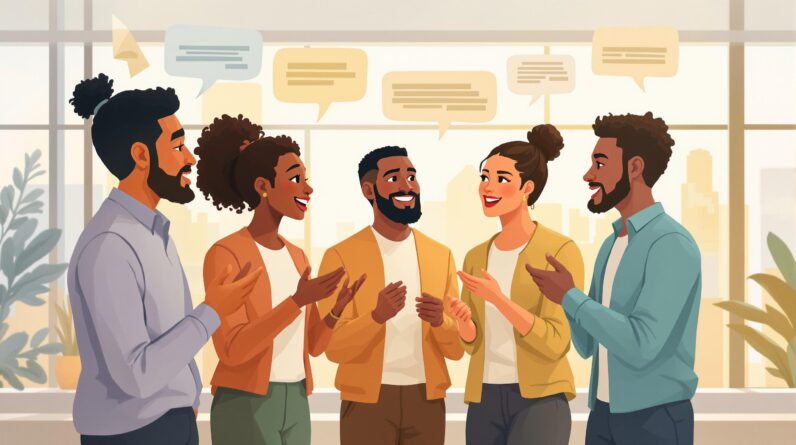
Struggling to stay motivated to exercise as you age? Neuro-Linguistic Programming (NLP) can help. It uses techniques like visualization, anchoring, and belief restructuring to tackle common challenges like fear of injury, low energy, and negative self-talk. Here’s how it works:
- Visualization: Imagine positive exercise outcomes to build confidence.
- Anchoring: Link workouts to enjoyable experiences like music or routines.
- Belief Shifting: Replace "I’m too old" with "It’s never too late."
NLP also supports setting practical fitness goals, improving mental well-being, and fostering lifelong habits. These tools make staying active easier, no matter your age. Read on to learn how you can use NLP to stay fit and motivated.
NLP Techniques for Motivation: Exercise
NLP Techniques to Stay Motivated for Fitness
Using Visualization to Stay Focused
Visualization can be a helpful tool for building motivation by imagining positive exercise experiences. Spend 5-10 minutes before your workout picturing yourself moving confidently and effortlessly. Focus on details like feeling your muscles grow stronger, improving your balance, or the satisfaction of completing your routine. Engaging your senses this way helps your brain connect exercise with positive outcomes. This is especially useful for older adults who may feel unsure about their fitness journey or disconnected from their goals.
Anchoring Positive Feelings to Exercise
Anchoring links exercise to enjoyable experiences, making it easier to stay motivated. Here are a few examples:
| Anchor Type | How to Create It | Benefit |
|---|---|---|
| Audio Anchor | Play upbeat music you love during workouts | Builds a positive mood and energy |
| Physical Anchor | Touch your wrist when feeling energized | Reminds you of positive emotions |
| Visual Anchor | Keep workout gear in sight | Acts as a regular visual reminder |
Changing Negative Beliefs About Fitness
Negative beliefs about exercise can hold people back, but NLP techniques can help replace them with more encouraging thoughts. Here’s how common limiting beliefs can be reframed:
| Limiting Belief | Empowering Alternative |
|---|---|
| "I’m too old to start exercising" | "It’s never too late to improve my fitness" |
| "Exercise will hurt my joints" | "The right exercises can strengthen my body" |
| "I don’t have enough energy" | "Being active will help boost my energy" |
Practicing these new beliefs regularly, alongside gentle and suitable physical activities, can reshape your mindset. These techniques can help you create a fitness plan that works for your needs as you age [4].
sbb-itb-d87b7ee
Using NLP to Support Fitness for Older Adults
Setting Practical Fitness Goals
NLP can assist older adults in setting fitness goals that are both realistic and manageable, emphasizing steady progress and enjoyable activities. Here’s how different goals can be approached:
| Goal Type | Example | NLP Technique |
|---|---|---|
| Mobility | Walking 30 minutes daily | Visualizing the end result |
| Balance | Standing on one foot 30 seconds | Focusing on gradual improvement |
| Flexibility | Touching toes while seated | Associating with positive emotions |
In addition to setting practical goals, maintaining mental and emotional well-being is essential for staying motivated.
Boosting Mental and Emotional Well-Being
A positive mindset is critical for keeping up with fitness routines. NLP tools can help seniors build a healthier relationship with exercise by highlighting immediate rewards such as better mood, improved sleep, and more energy.
"NLP can help seniors maintain a positive mindset and emotional balance by using techniques such as visualization and positive self-talk" [2].
For those managing chronic health conditions, focusing on abilities rather than limitations and celebrating small wins can make a big difference. These strategies can easily be added to fitness routines to make them more effective and enjoyable.
Practical Uses of NLP in Senior Fitness
By blending realistic goals, mental strategies, and visualization, older adults can create well-rounded fitness plans. For instance, before trying a new balance exercise, seniors might mentally rehearse the movement to boost confidence and reduce hesitation.
Incorporating NLP into fitness routines could involve using positive self-talk, imagining success before starting an activity, and creating motivational triggers. Programs that combine physical training with emotional support often see better results [3]. Regularly practicing these techniques can lead to habits that support both physical and mental health.
Creating a Fitness Plan with NLP
Building a Support Network
Using NLP techniques like mirroring and matching can improve communication with workout partners, instructors, and family members, helping everyone stay aligned on fitness goals [4].
Here’s how different types of support can play a role:
| Support Type | Role | How NLP Helps |
|---|---|---|
| Workout Partners | Provide companionship | Use shared positive anchors |
| Family Members | Offer emotional support | Communicate goals clearly |
| Fitness Instructors | Deliver professional guidance | Match their communication style |
| Support Groups | Share experiences | Apply group motivation techniques |
While building a support network is key, tracking your progress ensures you stay on the right path.
Tracking Progress and Staying Flexible
Keeping track of fitness progress involves monitoring both physical improvements and mental growth. NLP can help seniors stay motivated and view setbacks as learning opportunities [2].
To stay adaptable in your fitness journey, try visualization techniques. Picture yourself succeeding before every workout – this mental exercise builds confidence and resilience. Regularly reviewing your progress using NLP tools can reveal patterns and help fine-tune your goals as needed.
Tracking is important, but forming lasting habits is what keeps you moving forward.
Encouraging Lifelong Fitness Habits
After tracking progress, the focus shifts to creating an active lifestyle that lasts. NLP techniques like future pacing can help seniors imagine themselves as consistently active, reinforcing their commitment to exercise [1]. Research shows combining NLP with fitness routines boosts both physical and mental health [3].
You can strengthen habits by using NLP tools such as:
- Self-talk: Positive internal dialogue to stay motivated.
- Anchors: Associating certain actions or objects with positive emotions.
- Visualization: Mentally rehearsing success to build confidence.
- Milestone rewards: Celebrating achievements to maintain momentum.
"Fitness requires prioritizing yourself" [1].
This shift in mindset, paired with regular NLP practices, helps seniors maintain healthy habits. In fact, it can lower the risk of chronic diseases by up to 35% [3].
Conclusion: Using NLP to Stay Active as You Age
Key Takeaways
Applying NLP techniques regularly can boost your physical, mental, and emotional well-being [3]. These methods are especially helpful for seniors looking to overcome motivational challenges and maintain consistent fitness routines.
| Aspect | NLP Technique | Benefit |
|---|---|---|
| Physical Health | Visualization & Planning | Lower Risk of Chronic Illness |
| Mental Well-being | Positive Self-talk | Increased Confidence |
| Social Connection | Communication Skills | Stronger Relationships and Support |
With these methods, you’re better equipped to incorporate NLP into your fitness journey.
Where to Learn More
Getting started with NLP is straightforward. NLP Yourself (https://nlpyourself.com) provides practical strategies for seniors, including visualization, anchoring, and belief-shifting techniques highlighted in this article [1]. Their resources are tailored for personal growth and fitness motivation.
For a more personalized approach, working with certified NLP practitioners can help adapt these techniques to your unique needs [4]. Remember, staying active isn’t just about moving your body – it’s about cultivating the right mindset to support your goals at any stage of life.
Related Blog Posts
- 5 NLP Exercises to Boost Workplace Productivity
- NLP Goal Setting: A Practical Checklist for Success
- Beginner’s Guide to Neuro-Linguistic Programming
- How to Reframe Negative Self-Talk with NLP







